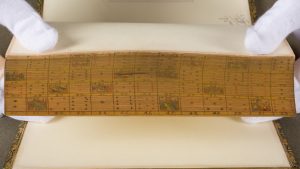Upon entering this class, my knowledge of fore-edge paintings was fairly limited. Last semester, I researched a pair of books from the 19th century, both with personalized fore-edge paintings, for another art history class. The process was absolutely fascinating, and opened my mind up to a technique I had never even heard of in the art world prior to Spring 2017. Other than that project, however, I was nervous about spending an entire semester on the subject, given my restricted familiarity. My worries quickly dissipated after spending time with the Knott family’s rare book collection at Loyola Notre Dame Library, a stunning group of Bibles, art books, and more. Plenty of these texts feature fore-edge paintings (some even have more than one on a single book!), and our access to them is nearly unlimited.
Handling the books personally makes a massive difference in the learning experience. Throughout this semester, we will have the opportunity to examine these texts as closely as we can, peering through the pages on by one, and spending as much time as necessary scanning the fore-edge paintings that line the outer edges. Previously, I was under the impression that fore-edge paintings were only found on religious texts – Bibles, Books of Common Prayer, and the like. However, I have recently discovered that these paintings can be found across many genres from the 18th, 19th, and 20th centuries. The Knott Collection features not only examples of those religious texts, but also pieces of classic literature, poetry, and other cultural touchstones. Fore-edge paintings range in subject matter from idealized landscapes to historical events to objects as random as antique furniture and a deck of cards.

Knott #149
During the preliminary stages of this research process, I am surprised and delighted by the variance within the library’s collection, and cannot wait to discover more throughout the remainder of the semester. At this point, I’m especially interested in exploring some of the non-religious texts within the collection, since I spent a fair amount of time researching Bibles last semester. What made consumers and dealers decide to add a fore-edge painting to a standard book? What about these texts sets them apart from the rest? When and where were these paintings added? I look forward to finding out more.
- Lucy Johnston
